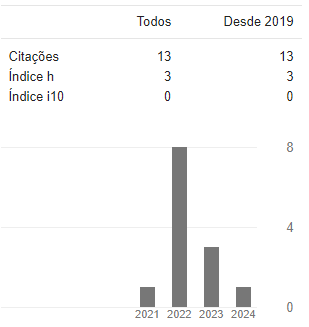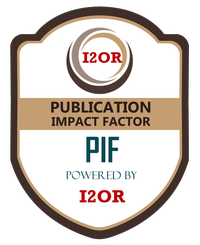ROS E O ESTRESSE OXIDATIVO POR SECA EM PLANTAS
Visualizações: 1595DOI:
https://doi.org/10.54038/ms.v3i3.44Palavras-chave:
Estresses ambientais. Espécies reativas de oxigênio. Sistema de defesa antioxidante. Peroxidação lipídica.Resumo
Plantas expostas a condições de estresses ambientais estão sujeitas a sofrer estresse oxidativo. A geração de espécies reativas de oxigênio (ROS) ocorre naturalmente em vários compartimentos celulares durante os processos metabólicos aeróbicos das plantas. Uma das estratégias das plantas para se proteger contra os efeitos deletérios do estresse oxidativo, é a manutenção dos baixos níveis de ROS através da ativação dos sistemas de defesa antioxidante enzimático ou não enzimático. A regulação das enzimas do sistema de defesa antioxidante está relacionada com a tolerância a estresses abióticos e pode garantir a proteção contra estresse oxidativo. Esta revisão objetivou fazer um apanhado de informações sobre a formação de ROS geradas durante o estresse oxidativo de plantas expostas à condição de seca. Foram selecionados artigos de acordo com a relevância do estudo e das informações sobre a fisiologia, bioquímia e anatomia de plantas sob estresse hídrico. O compilado de informações presentes nesta revisão auxiliam no desenvolvimento de novas pesquisas relacionadas à plantas sob estresses ambientais, possibilitando ampliar a obtenção de marcadores bioquímicos, fisiológicos e anatômicos relacionados com a defesa do estresse em questão.
Referências
Farooq MA, Niazi AK, Akhtar J, Saifullah, Farooq M, Souri Z, Karimi N, Rengel Z. Acquiring control: The evolution of ROS-Induced oxidative stress and redox signaling pathways in plant stress responses. Plant Physiol Biochem 2019; 141: 353-369. DOI: https://doi.org/10.1016/j.plaphy.2019.04.039
Mansoor S, Wani OA, Lone JK, Manhas S, Kour N, Alam P, Ahmad A, Ahmad. Reactive oxygen species in plants: from source to sink. Antioxidants 2022;11(225): 1-14. DOI: https://doi.org/10.3390/antiox11020225
Demidchik, V. Mechanisms of oxidative stress in plants: from classical chemistry to cell biology. Environmental and Experimental Botany 2015; 109: 212-228. DOI: https://doi.org/10.1016/j.envexpbot.2014.06.021
Inupakutika MA, Sengupta S, Devireddy AR, Azad RK, Mittler R. The evolution of reactive oxygen species metabolism. J Exp Bot 2016; 67(21): 5933-5943. DOI: https://doi.org/10.1093/jxb/erw382
Caverzan, A, Casassola, A, Brammer, S.P. Reactive oxygen species and antioxidant enzymes involved in plant tolerance to stress. In: Shanker, A.K, Shanker, C. Abiotic and biotic stress in plants - recent advances and future perspectives. Publisher: InTech, Chapters published, 2016. p. 463-480. DOI: https://doi.org/10.5772/61368
Dumanovic J, Nepovimova E, Natic, M, Kuc K, Jacevic V. The significance of reactive oxygen species and antioxidant defense system in plants: a concise overview. Front. Plant Sci. 2021; 11: 1-13. DOI: https://doi.org/10.3389/fpls.2020.552969
Liang X, Qian R, Wang D, Liu L, Sun C, Lin X. Lipid-Derived Aldehydes: New Key Mediators of Plant Growth and Stress Responses. Biology 2022; 11(11): 1590. DOI: https://doi.org/10.3390/biology11111590
Morales M, Munné-Bosch S. Malondialdehyde: Facts and Artifacts. Plant Physiol 2019; 180(3): 1246-1250. DOI: https://doi.org/10.1104/pp.19.00405
Souza LM, Oliveira MT, Morais MB, Palhares Neto L, Barbosa MR, Zarate-Salazar JR, Ulisses C, Camara TR. Does the type of substrate influence growth and antioxidant systems? Case study of Myracrodruon urundeuva under water deficit. S Afr J Bot 2022; 151: 841-851. DOI: https://doi.org/10.1016/j.sajb.2022.10.040
Durães FOM, Gama EEG, Santos FG, Guimarães CM, Ribeiro-Junior WQ, Trindade MG, Gomide RL, Albuquerque PEP. Fenotipagem para tolerância à seca: protocolos e características específicas visando o melhoramento genético de cereais. Embrapa, Circular Técnica n. 54 2004, ISSN 1518-4269.
Lichtenthaler HK. The stress concept in plants: an introduction. Ann NY Acad Sci 2006; 30(851): 187-198. DOI: https://doi.org/10.1111/j.1749-6632.1998.tb08993.x
Chaki M, Begara-Morales JC, Barroso JB. Oxidative Stress in Plants. Antioxidants 2020; 9(481): 2-4. doi:10.3390/antiox9060481 DOI: https://doi.org/10.3390/antiox9060481
Azzi A. Oxidative stress: What is it? Can it be measured? Where is it located? Can it be good or bad? Can it be prevented? Can it be cured? Antioxidants 2022; 11(1431): 1-11. DOI: https://doi.org/10.3390/antiox11081431
Mareri L, Luigi P, Giampiero C. Environmental stress and plants. Int J Mol Sci 2022; 23(10): 5416: 1-9. DOI: https://doi.org/10.3390/ijms23105416
Simova-Stoilova L, Vassileva V, Feller U. Selection and breeding of suitable crop genotypes for drought and heat periods in a changing climate: which morphological and physiological properties should be considered? Agriculture 2016; 6(26): 1-19. DOI: https://doi.org/10.3390/agriculture6020026
Bhattacharjee S. Sites of generation and physicochemical basis of formation of reactive oxygen species in plant cell. In: Gupta SD. Reactive oxygen species and antioxidants in higher plants. Enfield: Science Publishers, 2010. p. 1-30. DOI: https://doi.org/10.1201/9781439854082-2
Nordberg J, Arnér ESJ. Reactive oxygen species, antioxidants, and the mammalian thioredoxin system. Free radic biol med 2001; 31(11): 1287-1312. DOI: https://doi.org/10.1016/S0891-5849(01)00724-9
Xie X, He Z, Chen N, Tang Z, Wang Q, Cai Y. The roles of environmental factors in regulation of oxidative stress in plant. Biomed Res Int 2019; 23(5416): 1-9. DOI: https://doi.org/10.1155/2019/9732325
Puthur JT. Antioxidants and cellular antioxidation mechanism in plants. South Indian Journal of Biological Sciences 2016; 2(1): 14‐17. DOI: https://doi.org/10.22205/sijbs/2016/v2/i1/100335
Roach T, Krieger-Liszkay A. Regulation of photosynthetic electron transport and photoinhibition. Curr Protein Pept Sci 2014; 15(4): 351-362. DOI: https://doi.org/10.2174/1389203715666140327105143
Palhares Neto L, Souza LM, Morais MB, Arruda ECP, Figueiredo RCBQ, Albuquerque CC, Ulisses C. Morphophysiological and biochemical responses of Lippia grata Schauer (Verbenaceae) to water deficit. J Plant Growth Regul 2019; 1: 1-15. DOI: https://doi.org/10.1007/s00344-019-09961-6
Mor A, Koh E, Weiner L, Rosenwasser S, Sibony-Benyamini H, Fluhr R. Singlet oxygen signatures are detected independent of light or chloroplasts in response to multiple stresses. Plant Physiol 2014; 165(1): 249-261. DOI: https://doi.org/10.1104/pp.114.236380
Esteban R, Barrutia O, Artetxe U, Fernández-Marín B, Hernández A, García-Plazaola JI. Internal and external factors affecting photosynthetic pigment composition in plants: a meta-analytical approach. New Phytol 2015; 206: 268-280. DOI: https://doi.org/10.1111/nph.13186
Kim Y, Lee JH, Ha H, Im SW, Nam KT. Material science lesson from the biological photosystem. Nano Convergence 2016; 3(19): 1-11. DOI: https://doi.org/10.1186/s40580-016-0079-5
Sofo A, Scopa A, Nuzzaci M, Vitti A. Ascorbate Peroxidase and Catalase Activities and Their Genetic Regulation in Plants Subjected to Drought and Salinity Stresses. Int J Mol Sci 2015; 16(6): 13561-13578. DOI: https://doi.org/10.3390/ijms160613561
Souza LM, Barbosa MR, Morais MB, Neto LP, Ulisses C, Camara TR. Biochemical and morphophysiological strategies of Myracrodruon urundeuva plants under water deficit. Biol plant 2020; 64(1): 20-31. DOI: https://doi.org/10.32615/bp.2019.070
Bezerra FJ, Rezende AA, Rodrigues SJ, Almeida MG. Determinação das substâncias reativas ao ácido tiobarbitúrico como indicador da peroxidação lipídica em ratos tratados com sevoflurano. Rev Bras Anestesiol 2004; 54(5): 640-649. DOI: https://doi.org/10.1590/S0034-70942004000500004
Lima ES, Abdalla DSP. Peroxidação lipídica: mecanismos e avaliação em amostras biológicas. Rev Bras Ciênc Farm 2001; 37(3): 293-30.
Montillet JL, Cacas JL, Garnier L, Montané MH, Douki T, Bessoule JJ, Polkowska-Kowalczyk L, Maciejewska U, Agnel JP, Vial A, Triantaphylidès C. The upstream oxylipin profile of Arabidopsis thaliana: a tool to scan for oxidative stresses. Plant J 2004; 40(3): 439-451. DOI: https://doi.org/10.1111/j.1365-313X.2004.02223.x
Luz HKM, Wanderley LSLS, Faustino LR, Silva CMG, Figueiredo JR, Rodrigues APR. Papel de agentes antioxidantes na criopreservação de células germinativas e embriões. Acta Scientiae Veterinariae 2011; 39(2): 956: 1-15.
Ali Q, Ashraf, M. Induction of drought tolerance in maize (Zea mays L.) due to exogenous application of trehalose: growth, photosynthesis, water relations and oxidative defence mechanism. J Agro Crop Sci 2011; 197(4): 258-271. DOI: https://doi.org/10.1111/j.1439-037X.2010.00463.x
Ferreira, ICFR; Abreu, Rui M.V. Stress oxidativo, antioxidantes e fitoquímicos. Bioanálise 2007; 4(2): 32-39. DOI: https://doi.org/10.5628/rpcd.07.02.257
Barbosa MR, Silva MMA, Willadino L, Ulisses C, Camara, TR. Geração e desintoxicação enzimática de espécies reativas de oxigênio em plantas. Ciênc Rural 2014; 44(3): 453-460. DOI: https://doi.org/10.1590/S0103-84782014000300011
Eisenhut M, Brautigam A, Timm S, Florian A, Tohge T, Fernie AR, Bauwe H, Weber APM. Photorespiration is crucial for dynamic response of photosynthetic metabolism and stomatal movement to altered CO2 availability. Mol Plant 2017; 10: 47-61. DOI: https://doi.org/10.1016/j.molp.2016.09.011
Bao H, Morency M, Rianti R, Saeheng S, Roje S, Weber APM, Walker BJ. Catalase protects against nonenzymatic decarboxylations during photorespiration in Arabidopsis thaliana. Plant Direct 2021; 5: 1-13, e366. https://doi.org/10.1002/pld3.366 DOI: https://doi.org/10.1002/pld3.366
Roach T, Krieger-Liszkay A. Regulation of photosynthetic electron transport and photoinhibition. Curr Protein Pept Sci 2014; 15(4): 351-362. DOI: https://doi.org/10.2174/1389203715666140327105143
Publicado
Como Citar
Edição
Seção
Accepted 2023-06-19
Published 2023-07-06














